Jiale Cao
SSLFusion: Scale & Space Aligned Latent Fusion Model for Multimodal 3D Object Detection
Apr 07, 2025Abstract:Multimodal 3D object detection based on deep neural networks has indeed made significant progress. However, it still faces challenges due to the misalignment of scale and spatial information between features extracted from 2D images and those derived from 3D point clouds. Existing methods usually aggregate multimodal features at a single stage. However, leveraging multi-stage cross-modal features is crucial for detecting objects of various scales. Therefore, these methods often struggle to integrate features across different scales and modalities effectively, thereby restricting the accuracy of detection. Additionally, the time-consuming Query-Key-Value-based (QKV-based) cross-attention operations often utilized in existing methods aid in reasoning the location and existence of objects by capturing non-local contexts. However, this approach tends to increase computational complexity. To address these challenges, we present SSLFusion, a novel Scale & Space Aligned Latent Fusion Model, consisting of a scale-aligned fusion strategy (SAF), a 3D-to-2D space alignment module (SAM), and a latent cross-modal fusion module (LFM). SAF mitigates scale misalignment between modalities by aggregating features from both images and point clouds across multiple levels. SAM is designed to reduce the inter-modal gap between features from images and point clouds by incorporating 3D coordinate information into 2D image features. Additionally, LFM captures cross-modal non-local contexts in the latent space without utilizing the QKV-based attention operations, thus mitigating computational complexity. Experiments on the KITTI and DENSE datasets demonstrate that our SSLFusion outperforms state-of-the-art methods. Our approach obtains an absolute gain of 2.15% in 3D AP, compared with the state-of-art method GraphAlign on the moderate level of the KITTI test set.
CLIPer: Hierarchically Improving Spatial Representation of CLIP for Open-Vocabulary Semantic Segmentation
Nov 21, 2024



Abstract:Contrastive Language-Image Pre-training (CLIP) exhibits strong zero-shot classification ability on various image-level tasks, leading to the research to adapt CLIP for pixel-level open-vocabulary semantic segmentation without additional training. The key is to improve spatial representation of image-level CLIP, such as replacing self-attention map at last layer with self-self attention map or vision foundation model based attention map. In this paper, we present a novel hierarchical framework, named CLIPer, that hierarchically improves spatial representation of CLIP. The proposed CLIPer includes an early-layer fusion module and a fine-grained compensation module. We observe that, the embeddings and attention maps at early layers can preserve spatial structural information. Inspired by this, we design the early-layer fusion module to generate segmentation map with better spatial coherence. Afterwards, we employ a fine-grained compensation module to compensate the local details using the self-attention maps of diffusion model. We conduct the experiments on seven segmentation datasets. Our proposed CLIPer achieves the state-of-the-art performance on these datasets. For instance, using ViT-L, CLIPer has the mIoU of 69.8% and 43.3% on VOC and COCO Object, outperforming ProxyCLIP by 9.2% and 4.1% respectively.
VideoGLaMM: A Large Multimodal Model for Pixel-Level Visual Grounding in Videos
Nov 07, 2024



Abstract:Fine-grained alignment between videos and text is challenging due to complex spatial and temporal dynamics in videos. Existing video-based Large Multimodal Models (LMMs) handle basic conversations but struggle with precise pixel-level grounding in videos. To address this, we introduce VideoGLaMM, a LMM designed for fine-grained pixel-level grounding in videos based on user-provided textual inputs. Our design seamlessly connects three key components: a Large Language Model, a dual vision encoder that emphasizes both spatial and temporal details, and a spatio-temporal decoder for accurate mask generation. This connection is facilitated via tunable V-L and L-V adapters that enable close Vision-Language (VL) alignment. The architecture is trained to synchronize both spatial and temporal elements of video content with textual instructions. To enable fine-grained grounding, we curate a multimodal dataset featuring detailed visually-grounded conversations using a semiautomatic annotation pipeline, resulting in a diverse set of 38k video-QA triplets along with 83k objects and 671k masks. We evaluate VideoGLaMM on three challenging tasks: Grounded Conversation Generation, Visual Grounding, and Referring Video Segmentation. Experimental results show that our model consistently outperforms existing approaches across all three tasks.
DB-SAM: Delving into High Quality Universal Medical Image Segmentation
Oct 05, 2024Abstract:Recently, the Segment Anything Model (SAM) has demonstrated promising segmentation capabilities in a variety of downstream segmentation tasks. However in the context of universal medical image segmentation there exists a notable performance discrepancy when directly applying SAM due to the domain gap between natural and 2D/3D medical data. In this work, we propose a dual-branch adapted SAM framework, named DB-SAM, that strives to effectively bridge this domain gap. Our dual-branch adapted SAM contains two branches in parallel: a ViT branch and a convolution branch. The ViT branch incorporates a learnable channel attention block after each frozen attention block, which captures domain-specific local features. On the other hand, the convolution branch employs a light-weight convolutional block to extract domain-specific shallow features from the input medical image. To perform cross-branch feature fusion, we design a bilateral cross-attention block and a ViT convolution fusion block, which dynamically combine diverse information of two branches for mask decoder. Extensive experiments on large-scale medical image dataset with various 3D and 2D medical segmentation tasks reveal the merits of our proposed contributions. On 21 3D medical image segmentation tasks, our proposed DB-SAM achieves an absolute gain of 8.8%, compared to a recent medical SAM adapter in the literature. The code and model are available at https://github.com/AlfredQin/DB-SAM.
iSeg: An Iterative Refinement-based Framework for Training-free Segmentation
Sep 05, 2024



Abstract:Stable diffusion has demonstrated strong image synthesis ability to given text descriptions, suggesting it to contain strong semantic clue for grouping objects. Inspired by this, researchers have explored employing stable diffusion for trainingfree segmentation. Most existing approaches either simply employ cross-attention map or refine it by self-attention map, to generate segmentation masks. We believe that iterative refinement with self-attention map would lead to better results. However, we mpirically demonstrate that such a refinement is sub-optimal likely due to the self-attention map containing irrelevant global information which hampers accurately refining cross-attention map with multiple iterations. To address this, we propose an iterative refinement framework for training-free segmentation, named iSeg, having an entropy-reduced self-attention module which utilizes a gradient descent scheme to reduce the entropy of self-attention map, thereby suppressing the weak responses corresponding to irrelevant global information. Leveraging the entropy-reduced self-attention module, our iSeg stably improves refined crossattention map with iterative refinement. Further, we design a category-enhanced cross-attention module to generate accurate cross-attention map, providing a better initial input for iterative refinement. Extensive experiments across different datasets and diverse segmentation tasks reveal the merits of proposed contributions, leading to promising performance on diverse segmentation tasks. For unsupervised semantic segmentation on Cityscapes, our iSeg achieves an absolute gain of 3.8% in terms of mIoU compared to the best existing training-free approach in literature. Moreover, our proposed iSeg can support segmentation with different kind of images and interactions.
Parameter-Efficient Fine-Tuning for Continual Learning: A Neural Tangent Kernel Perspective
Jul 24, 2024
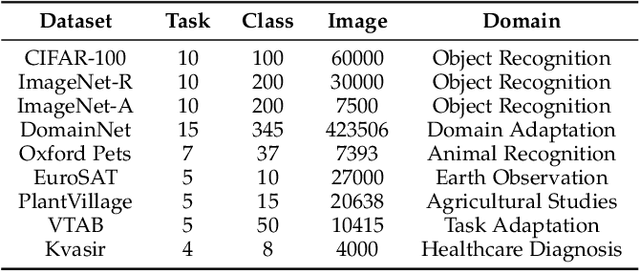
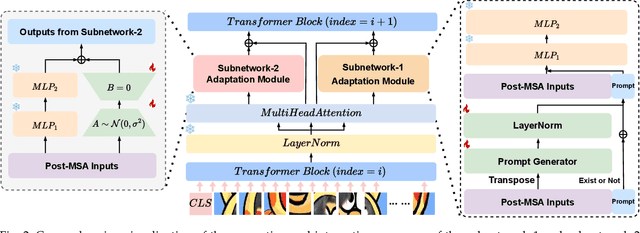

Abstract:Parameter-efficient fine-tuning for continual learning (PEFT-CL) has shown promise in adapting pre-trained models to sequential tasks while mitigating catastrophic forgetting problem. However, understanding the mechanisms that dictate continual performance in this paradigm remains elusive. To tackle this complexity, we undertake a rigorous analysis of PEFT-CL dynamics to derive relevant metrics for continual scenarios using Neural Tangent Kernel (NTK) theory. With the aid of NTK as a mathematical analysis tool, we recast the challenge of test-time forgetting into the quantifiable generalization gaps during training, identifying three key factors that influence these gaps and the performance of PEFT-CL: training sample size, task-level feature orthogonality, and regularization. To address these challenges, we introduce NTK-CL, a novel framework that eliminates task-specific parameter storage while adaptively generating task-relevant features. Aligning with theoretical guidance, NTK-CL triples the feature representation of each sample, theoretically and empirically reducing the magnitude of both task-interplay and task-specific generalization gaps. Grounded in NTK analysis, our approach imposes an adaptive exponential moving average mechanism and constraints on task-level feature orthogonality, maintaining intra-task NTK forms while attenuating inter-task NTK forms. Ultimately, by fine-tuning optimizable parameters with appropriate regularization, NTK-CL achieves state-of-the-art performance on established PEFT-CL benchmarks. This work provides a theoretical foundation for understanding and improving PEFT-CL models, offering insights into the interplay between feature representation, task orthogonality, and generalization, contributing to the development of more efficient continual learning systems.
Multi-Granularity Language-Guided Multi-Object Tracking
Jun 07, 2024



Abstract:Most existing multi-object tracking methods typically learn visual tracking features via maximizing dis-similarities of different instances and minimizing similarities of the same instance. While such a feature learning scheme achieves promising performance, learning discriminative features solely based on visual information is challenging especially in case of environmental interference such as occlusion, blur and domain variance. In this work, we argue that multi-modal language-driven features provide complementary information to classical visual features, thereby aiding in improving the robustness to such environmental interference. To this end, we propose a new multi-object tracking framework, named LG-MOT, that explicitly leverages language information at different levels of granularity (scene-and instance-level) and combines it with standard visual features to obtain discriminative representations. To develop LG-MOT, we annotate existing MOT datasets with scene-and instance-level language descriptions. We then encode both instance-and scene-level language information into high-dimensional embeddings, which are utilized to guide the visual features during training. At inference, our LG-MOT uses the standard visual features without relying on annotated language descriptions. Extensive experiments on three benchmarks, MOT17, DanceTrack and SportsMOT, reveal the merits of the proposed contributions leading to state-of-the-art performance. On the DanceTrack test set, our LG-MOT achieves an absolute gain of 2.2\% in terms of target object association (IDF1 score), compared to the baseline using only visual features. Further, our LG-MOT exhibits strong cross-domain generalizability. The dataset and code will be available at ~\url{https://github.com/WesLee88524/LG-MOT}.
VFMM3D: Releasing the Potential of Image by Vision Foundation Model for Monocular 3D Object Detection
Apr 15, 2024Abstract:Due to its cost-effectiveness and widespread availability, monocular 3D object detection, which relies solely on a single camera during inference, holds significant importance across various applications, including autonomous driving and robotics. Nevertheless, directly predicting the coordinates of objects in 3D space from monocular images poses challenges. Therefore, an effective solution involves transforming monocular images into LiDAR-like representations and employing a LiDAR-based 3D object detector to predict the 3D coordinates of objects. The key step in this method is accurately converting the monocular image into a reliable point cloud form. In this paper, we present VFMM3D, an innovative approach that leverages the capabilities of Vision Foundation Models (VFMs) to accurately transform single-view images into LiDAR point cloud representations. VFMM3D utilizes the Segment Anything Model (SAM) and Depth Anything Model (DAM) to generate high-quality pseudo-LiDAR data enriched with rich foreground information. Specifically, the Depth Anything Model (DAM) is employed to generate dense depth maps. Subsequently, the Segment Anything Model (SAM) is utilized to differentiate foreground and background regions by predicting instance masks. These predicted instance masks and depth maps are then combined and projected into 3D space to generate pseudo-LiDAR points. Finally, any object detectors based on point clouds can be utilized to predict the 3D coordinates of objects. Comprehensive experiments are conducted on the challenging 3D object detection dataset KITTI. Our VFMM3D establishes a new state-of-the-art performance. Additionally, experimental results demonstrate the generality of VFMM3D, showcasing its seamless integration into various LiDAR-based 3D object detectors.
Implicit and Explicit Language Guidance for Diffusion-based Visual Perception
Apr 11, 2024Abstract:Text-to-image diffusion models have shown powerful ability on conditional image synthesis. With large-scale vision-language pre-training, diffusion models are able to generate high-quality images with rich texture and reasonable structure under different text prompts. However, it is an open problem to adapt the pre-trained diffusion model for visual perception. In this paper, we propose an implicit and explicit language guidance framework for diffusion-based perception, named IEDP. Our IEDP comprises of an implicit language guidance branch and an explicit language guidance branch. The implicit branch employs frozen CLIP image encoder to directly generate implicit text embeddings that are fed to diffusion model, without using explicit text prompts. The explicit branch utilizes the ground-truth labels of corresponding images as text prompts to condition feature extraction of diffusion model. During training, we jointly train diffusion model by sharing the model weights of these two branches. As a result, implicit and explicit branches can jointly guide feature learning. During inference, we only employ implicit branch for final prediction, which does not require any ground-truth labels. Experiments are performed on two typical perception tasks, including semantic segmentation and depth estimation. Our IEDP achieves promising performance on both tasks. For semantic segmentation, our IEDP has the mIoU score of 55.9% on AD20K validation set, which outperforms the baseline method VPD by 2.2%. For depth estimation, our IEDP outperforms the baseline method VPD with a relative gain of 10.2%.
SGD: Street View Synthesis with Gaussian Splatting and Diffusion Prior
Mar 29, 2024
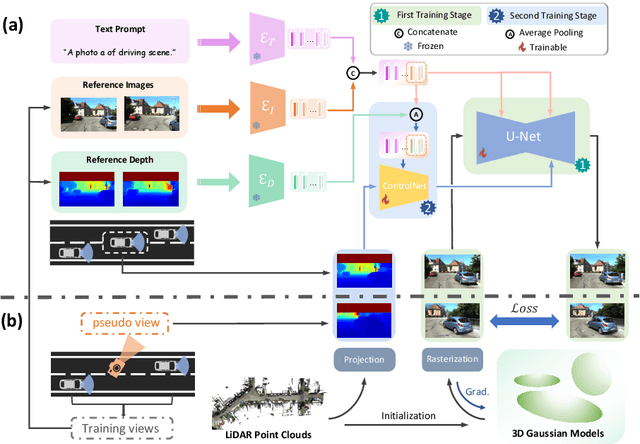
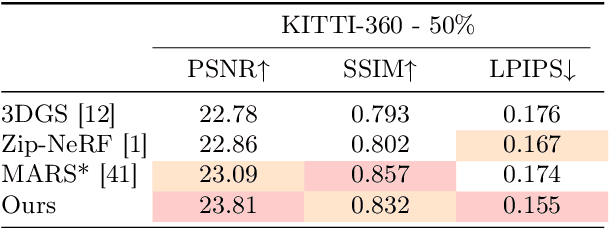
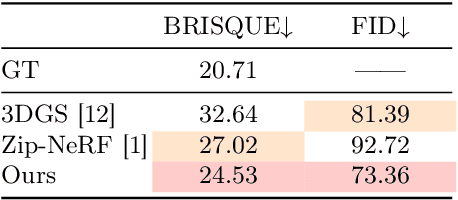
Abstract:Novel View Synthesis (NVS) for street scenes play a critical role in the autonomous driving simulation. The current mainstream technique to achieve it is neural rendering, such as Neural Radiance Fields (NeRF) and 3D Gaussian Splatting (3DGS). Although thrilling progress has been made, when handling street scenes, current methods struggle to maintain rendering quality at the viewpoint that deviates significantly from the training viewpoints. This issue stems from the sparse training views captured by a fixed camera on a moving vehicle. To tackle this problem, we propose a novel approach that enhances the capacity of 3DGS by leveraging prior from a Diffusion Model along with complementary multi-modal data. Specifically, we first fine-tune a Diffusion Model by adding images from adjacent frames as condition, meanwhile exploiting depth data from LiDAR point clouds to supply additional spatial information. Then we apply the Diffusion Model to regularize the 3DGS at unseen views during training. Experimental results validate the effectiveness of our method compared with current state-of-the-art models, and demonstrate its advance in rendering images from broader views.
 Add to Chrome
Add to Chrome Add to Firefox
Add to Firefox Add to Edge
Add to Edge